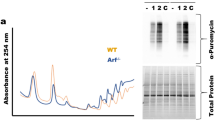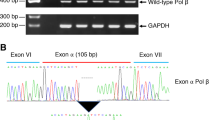Abstract
Nijmegen breakage syndrome (NBS) is a rare chromosomal-instability syndrome associated with cancer predisposition, radiosensitivity and radioresistant DNA synthesis–S phase checkpoint deficiency, which results in the failure to suppress DNA replication origins following DNA damage. Approximately 90% of NBS patients are homozygous for the 657del5 allele1,2, a truncating mutation of NBS1 that causes premature termination at codon 219. Because null mutations in MRE11 and RAD50, which encode binding partners of NBS1, are lethal in vertebrates3,4,5, and mouse Nbs1-null mutants are inviable6, we tested the hypothesis that the NBS1 657del5 mutation was a hypomorphic defect. We showed that NBS cells contain the predicted 26-kD amino-terminal protein fragment, NBS1p26, and a 70-kD NBS1 protein (NBS1p70) lacking the native N terminus. The NBSp26 protein is not physically associated with the MRE11 complex, whereas the p70 species is physically associated with it. NBS1p70 is produced by internal translation initiation within the NBS1 mRNA using an open reading frame generated by the 657del5 frameshift. We propose that the common NBS1 allele encodes a partially functional protein that diminishes the severity of the NBS phenotype.
This is a preview of subscription content, access via your institution
Access options
Subscribe to this journal
Receive 12 print issues and online access
$209.00 per year
only $17.42 per issue
Buy this article
- Purchase on Springer Link
- Instant access to full article PDF
Prices may be subject to local taxes which are calculated during checkout





Similar content being viewed by others
References
The Nijmegen breakage syndrome consortium. Nijmegen breakage syndrome. Arch. Dis. Child 82, 400–406 (2000).
Varon, R. et al. Nibrin, a novel DNA double-strand break repair protein, is mutated in Nijmegen breakage syndrome. Cell 93, 467–476 (1998).
Xiao, Y. & Weaver, D.T. Conditional gene targeted deletion by Cre recombinase demonstrates the requirement for the double-strand break repair Mre11 protein in murine embryonic stem cells. Nucleic Acids Res. 25, 2985–2991 (1997).
Luo, G. et al. Disruption of mRad50 causes embryonic stem cell lethality, abnormal embryonic development, and sensitivity to ionizing radiation. Proc. Natl. Acad. Sci. USA 96, 7376–7381 (1999).
Yamaguchi-Iwai, Y. et al. Mre11 is essential for the maintenance of chromosomal DNA in vertebrate cells. EMBO J. 18, 6619–6629 (1999).
Zhu, J., Petersen, S. & Tessarolla & Nussenzweig, A. Targeted disruption of the Nijmegen breakage syndrome gene NBS1 leads to early embryonic lethality in mice. Curr. Biol. 11, 105–109 (2001).
Carney, J.P. et al. The hMre11/hRad50 protein complex and Nijmegen breakage syndrome: linkage of double-strand break repair to the cellular DNA damage response. Cell 93, 477–486 (1998).
Thomas, K.R. & Capecchi, M.R. Introduction of homologous DNA sequences into mammalian cells induces mutations in the cognate gene. Nature 324, 34–38 (1986).
Geballe, A.P. Translational control mediated by upstream AUG codons. in Translational Control (eds. Hershey, J.W.B., Mathews, M.B. & Sonenburg, N.S.) 173–197 (Cold Spring Harbor Laboratory Press, Plainview, NY, 1996).
Holcik, M., Lefebvre, C., Yeh, C., Chow, T. & Korneluk, R.G. A new internal-ribosome-entry-site motif potentiates XIAP-mediated cytoprotection. Nature Cell Biol. 1, 190–192 (1999).
Pyronnet, S., Pradayrol, L. & Sonenberg, N. A cell cycle-dependent internal ribosome entry site. Mol. Cell 5, 607–616 (2000).
Tupler, R. et al. A variant of the Nijmegen breakage syndrome with unusual cytogenetic features and intermediate cellular radiosensitivity. J. Med. Genet. 34, 196–202 (1997).
Stewart, G.S. et al. The DNA double strand break repair gene hMre11, is mutated in individuals with a new ataxia telangiectasia like disorder (ATLD). Cell 99, 577–587 (1999).
Lim, D.-S. et al. ATM phosphorylates p95/nbs1 in an S-phase checkpoint pathway. Nature 404, 613–617 (2000).
de Wet, J.R., Wood, K.V., DeLuca, M., Helinski, D.R. & Subramani, S. Firefly luciferase gene: structure and expression in mammalian cells. Mol. Cell. Biol. 7, 725–737 (1987).
Zhao, S. et al. Functional link between ataxia-telangiectasia and Nijmegen breakage syndrome gene products. Nature 405, 473–477 (2000).
Acknowledgements
We thank P. Maraschio, R. Varon and B. Sugden for cell lines; P. Farnham for pcDNA3 and the luciferase cDNA; T. de Lange for TRF2 antiserum; E. Zegna, J. Wells and members of the Petrini laboratory for comments and helpful discussions. This work was supported by grants from the Milwaukee Foundation, the National Institutes of Health GM59413 and the D.O.E. ER62859.
Author information
Authors and Affiliations
Corresponding author
Rights and permissions
About this article
Cite this article
Maser, R., Zinkel, R. & Petrini, J. An alternative mode of translation permits production of a variant NBS1 protein from the common Nijmegen breakage syndrome allele. Nat Genet 27, 417–421 (2001). https://doi.org/10.1038/86920
Received:
Accepted:
Issue Date:
DOI: https://doi.org/10.1038/86920
This article is cited by
-
NBS1 interacts with HP1 to ensure genome integrity
Cell Death & Disease (2019)
-
Nijmegen Breakage Syndrome fibroblasts and iPSCs: cellular models for uncovering disease-associated signaling pathways and establishing a screening platform for anti-oxidants
Scientific Reports (2017)
-
Directed Alternative Splicing in Nijmegen Breakage Syndrome: Proof of Principle Concerning Its Therapeutical Application
Molecular Therapy (2016)
-
An adult patient with Nijmegen Breakage Syndrome and Hodgkin's Lymphoma
BMC Hematology (2014)
-
NBN Phosphorylation regulates the accumulation of MRN and ATM at sites of DNA double-strand breaks
Oncogene (2013)



